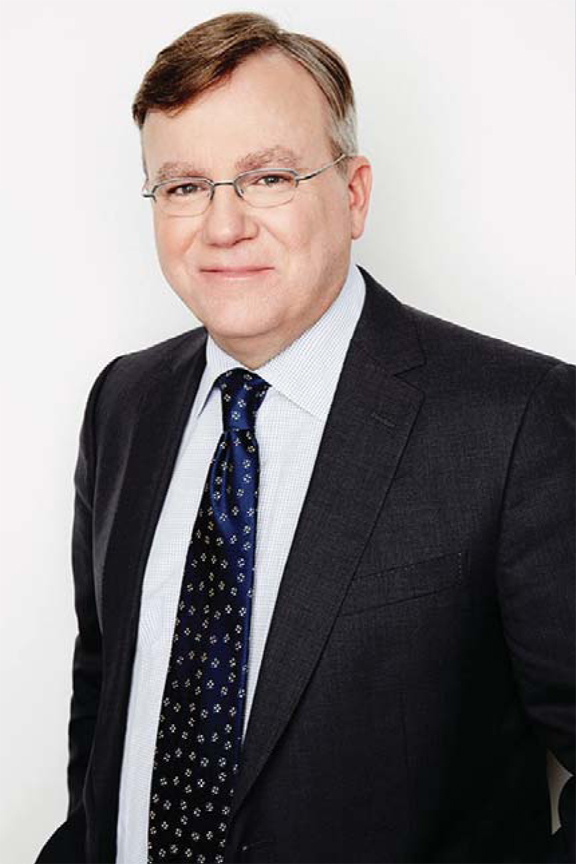Michael Crotty: Spreading the Word

As CMO and EVP of Hudson’s Bay and Lord & Taylor, Michael Crotty elevates the message.

What’s your mission for Lord & Taylor?
About a year ago, when Liz was building her team at Lord & Taylor, one of the first things we did was define what the brand stood for. We looked at our heritage and where we sat in the competitive marketplace, we looked at our strengths and weaknesses, and we decided Lord & Taylor would always lead with fashion, deliver great value and extraordinary service. And that’s important to us because we don’t want to be a building full of “stuff.” We are an edited fashion destination for men and women. We want to make it easy for a guy to find something to wear to work on a Tuesday or out on a Saturday night. Because when you look your best, you feel your best, and we want to help guys with that. Our price points are not at the highest end, but we don’t go that low either. We actually have a very good mix of price points and a really good edit for all aspects of his life today whether it’s work, evening or the weekend.
As far as defining this, we didn’t get hung up on age: I think anyone who talks about age today is a little out of date. It’s more about a mindset—whether he’s 25, 45 or 55, we have options for him. We also have the value part of the equation, which is an important distinction. We have a really good fashion point of view but our model is promotional. We are going to deliver great value, so we appeal to a customer for whom that’s important and we follow it up with service. If you’re looking for a suit or exploring new areas in denim, there’s someone there to help you. There’s someone who will help you get fitted as opposed to someone just taking your money at the register. Our sellers do a great job, and that’s where we shine.
How are you communicating your new mission and updated image to your customers?
We spent the past six to nine months elevating our marketing materials across all customer touch points; we looked at how we’re telling our story digitally. How are we telling it with our important catalogs? In print and digital ads? We studied everything and found some inconsistencies, but we knew we had an opportunity to tell a more holistic story and tell it in a more elevated, modern way.
For spring 2015, we shot our men’s book in Palm Springs. We sent it to a segment of our male customers and women who buy for men. We’re using it for prospecting both in print and digitally where it’s a little more efficient. We’re featuring great brands with amazing styling and storytelling to connect with a new guy. We have nine full-page color ads running in The New York Times and three are men’s. This is an impactful branding campaign.
How are you telling the story for Hudson’s Bay?
Lord & Taylor is a regional department store; Hudson’s Bay has 90 stores across Canada, serving a wider audience from Vancouver to Toronto. There are lots of similarities between the male shoppers and the brand matrix is somewhat similar. Our marketing approach is not that different: it’s getting the message across that we have great brands, great fashion at a great value for all aspects of a guy’s life. When guys come in, they see an extremely clear edit, which makes it a lot easier for marketing to tell the story. We’re taking an elevated, editorial approach to tell guys that we’re a modern department store.
Then we took it a step further by creating a premium book for the more advanced customer who lives in cities like Vancouver, Montreal and Toronto. For a 344-year-old department store, this book is very modern and it gets people’s attention. We send these to women, who might not buy the product, but it changes her impression of the store and she wants her guy to shop here.
The men’s book has a circulation of over one million. The premium book is more targeted because the product is mostly in top doors. To spend the money to get it out in the middle of the country doesn’t make sense, but it’s good for positioning in those key markets.
Can you discuss your digital strategy?
E-commerce continues to be one of our biggest growth areas and we’re able to add some of the newer brands online that might not be in all doors. That’s the beauty of e-commerce: it opens selling opportunities for our sales associates in our stores. We have a program where we can auto-locate anything in any door and ship it for free. So let’s say a guy sees this ad while traveling, but can’t find the item in his home store. We can look it up in our POS and ship it to his home for free. We do a lot of digital marketing. We use all the traditional channels like paid search marketing and affiliate programs, but we do quite a lot of campaigns too. We work with Thrillist, GQ.com and NYPost.com, prospecting with these sites because we know that’s what our customers are reading.
Do you still advertise in New York taxis?
Yes! We just shot our new spring video. Basically, every time we do a photo shoot, we shoot video too. We’re using the videos on our website, with some of our online partners, and in taxi cabs where appropriate.
How do you break down digital to print to broadcast?
We forced ourselves to look for ways to direct more of our budget towards digital. So we are spending proportionally more digitally today than we were two years ago for sure. We’ve been methodical about how we invest digitally. It’s driving our e-commerce business and it’s driving our store business. When we find it works, we shift. So it’s a pretty organic process. But we haven’t backed away from print because it does three things: it positions our brand, it tells our story and it drives people into the store and online.
What events entice your male customers?
We have an interesting model that we call Guy’s Night Out. It was widely successful for Lord & Taylor, so we took it up north to Hudson’s Bay. It’s a party atmosphere with food and drink: we get great vendor participation and we have professional athletes attend. Guys will come and bring their girlfriend or partner and everyone has a fun time experiencing the brand. We do a lot of business that night, but most importantly we’re exposing the floor to people who might not have shopped with us before.
You just launched Beacon Technology in all doors. Can you tell us about this strategy?
The idea came from wanting to try something new. We all know that everyone walks around with phones these days. Customers who download the Beacon app to their phones are opting in and actually want some kind of communication from us. It doesn’t cost them or us anything so it’s really quite simple. If a consumer downloads the app and walks into the store, the technology notices if you’re near Hugo Boss for example, and it sends a notification that says Hugo Boss ties are on sale. It just pushes a message to your phone. It could be a coupon, an offer, a piece of news or informing you of a GWP. We tested a little of everything, and you can opt out so you manage it yourself.
What are your interests outside of work?
I grew up in Virginia and I love horses. I’m a big equestrian and I do competitive jumping. My colleagues hear about it all the time because it’s a big part of my personal life. I was a founding board member and vice chairman of Shop.org, the e-commerce division of the National Retail Federation. I’m also a member of the board of Stonewall Kitchen and a frequent speaker at industry events on retail marketing.




